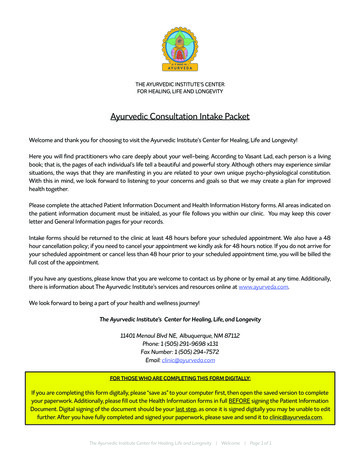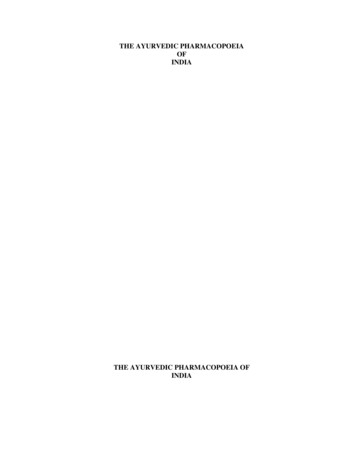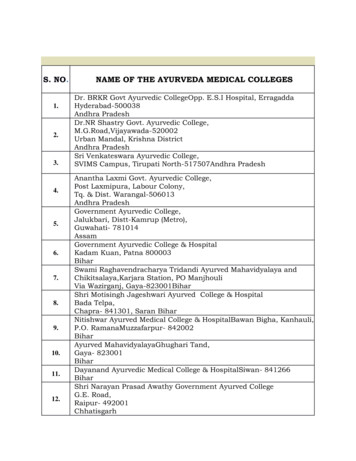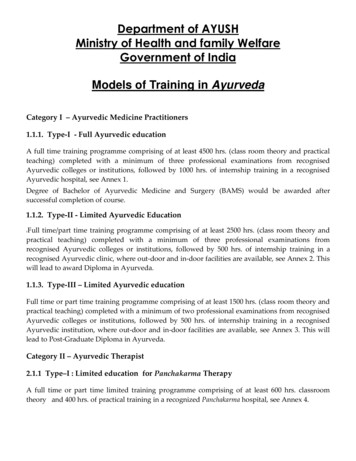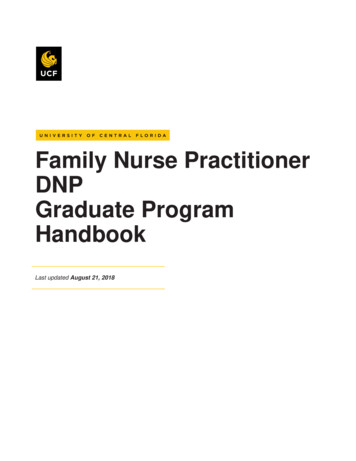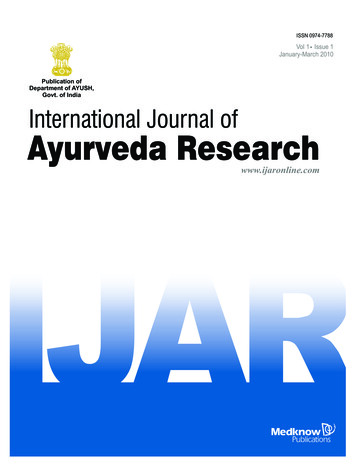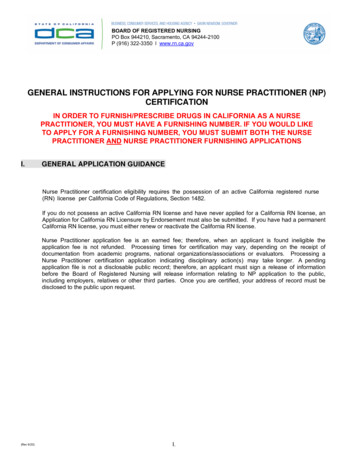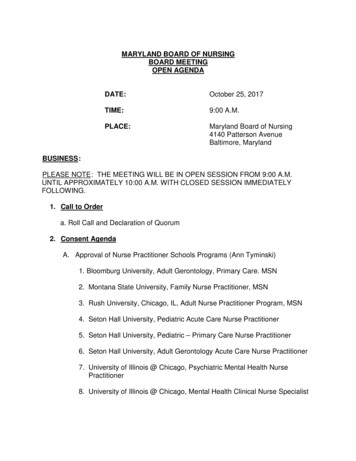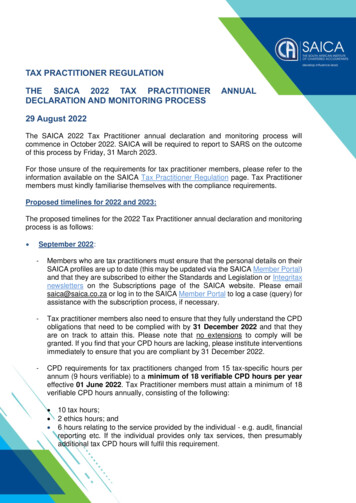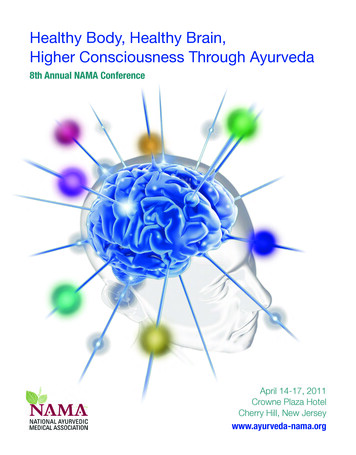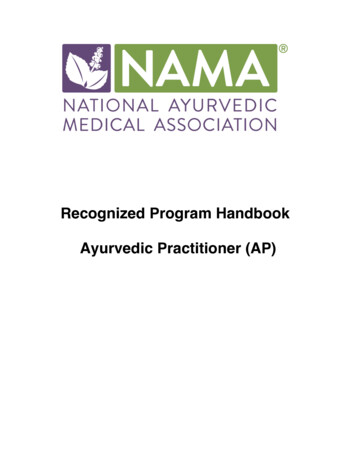
Transcription
Recognized Program HandbookAyurvedic Practitioner (AP)
PART ONE – BACKGROUND INFORMATIONA. Purpose of the NAMA Recognized Program HandbookThe NAMA Recognized Program Handbook serves as the principal source ofinformation for applicants of NAMA Recognized Ayurvedic programs and for existingNAMA Recognized programs. This handbook contains the most recent information onNAMA recognition and all support documents required for the schools to apply for andmaintain their NAMA recognition status.1. Mission of NAMAFounded in 1998, The National Ayurvedic Medical Association (NAMA) represents theAyurvedic profession in the United States. NAMA’s mission is to preserve, protect,improve and promote the philosophy, knowledge, science and practice of Ayurveda forthe benefit of humanity. More NAMA information can be found atwww.ayurvedanama.org.To further its mission, NAMA established the NAMA Standards Committee and ProgramReview Sub-committee to Develop and revise standards, policies, and procedures for recognizingAyurvedic professional programs;Process and review program applications;Oversee the administration of program recognition andAward NAMA program recognition.2. Standards CommitteeThe members of the NAMA Standards Committee and the NAMA Program ReviewSubcommittee are composed of select NAMA board members, NAMA’s ExecutiveDirector and NAMA volunteers. The committee meets at least once per month.The NAMA Program Review Committee currently recognizes the following Ayurvedicprograms: Ayurvedic Health CounselorAyurvedic PractitionerAyurvedic DoctorAyurvedic Yoga TherapistRevised 08/20/20(edit corrections 10/08/20)Page 2NAMA Recognized Program Handbook
NAMA program recognition demonstrates that a program has met current programstandards approved by NAMA’s board. These standards and support documents, in theaccompanying appendixes, include: Appendix A: Legal Proof of OperationAppendix B: Educational Requirements including pre-requirementsAppendix C: Definitions document (coming soon)Appendix D: Sample school transcriptAppendix E: Education Outline for Competencies in each specific programAppendix F: Scope of Practice for each specific category of professional(support document for the Outline for Competencies)Appendix G: Annual Program Review FormAppendix H: School AcknowledgementAppendix I: NAMA Certification Board and Certification Exam informationAppendix J: New RequirementsB. Non-Discrimination PolicyThe NAMA board does not discriminate on the basis of race, color, age, gender, sexualorientation, political or religious beliefs, handicap, marital status, national origin orancestry.C. Contacting NAMAMost information needed by NAMA recognition program applicants is available on theNAMA website http://www.ayurvedanama.org. The information assists applicantsmoving through the application processes. Applicants are encouraged to use theresources available, and to contact NAMA with specific questions if they cannot find theinformation they need.NAMA staff may be reached at (213) 628-6291 or nama@ayurvedanama.org.Correspondence and document hard copies may also be mailed to 8605 Santa MonicaBlvd, #46789, Los Angeles, CA 90069PART TWO – APPLICATION PROCESSRevised 08/20/20(edit corrections 10/08/20)Page 3NAMA Recognized Program Handbook
A. Indicate Program Recognition InterestSchools begin the process by indicating to NAMA that they would like their program tobecome NAMA Recognized on the Apply for Program Recognition form.When a school is ready to apply for program recognition, school representatives arepresented with a link to this handbook and sent an email invitation to an orientationsession.B. Orientation SessionProgram recognition orientation sessions are held quarterly or biannually, depending oninterest. After you indicate your interest by sending NAMA the above-mentioned form,staff will inform you of the next information session. School representatives are requiredto attend a session to hear an overview of the program recognition process, askquestions, and benefit from the questions of others. The schedule for informationsessions will also be posted on NAMA’s website.The session will explain the following: NAMA’s Scope of Practice document, which encompasses what each level ofprogram education can and cannot do;Our Educational Competency Guidelines (Appendix E) that dictate the curriculumall NAMA Recognized programs must meet;NAMA’s Educational Requirements (hours, patient encounter requirements,anatomy and physiology requirements, etc.);Definitions;Best practices for setting up your school (e.g., legal standing in your state,catalog, website, student policies);What it means to be NAMA Recognized and what is expected of both NAMA andthe school; andThe NAMA Certification Board exam (NAMACB) and what it means for yourgraduates to become NAMA Professional Members.C. Application ProcessRevised 08/20/20(edit corrections 10/08/20)Page 4NAMA Recognized Program Handbook
After attending an orientation session, you can indicate your intention to apply forrecognition to NAMA staff, and you then will be forwarded a link to the application formand information about the application process.PART THREE – ELIGIBILITY REQUIREMENTSTo be eligible for NAMA recognition, Ayurvedic Health Counselor programs must meetthe following requirements: Provide 600–1,000 hours of Ayurvedic education as laid out in the “AHCEducational Outline for Competencies” (see Appendix E)Provide proof of legal operation in the state where the program legally doesbusinessRequire Western Anatomy & Physiology prerequisite/corequisite—above andbeyond the 600-hour minimum (see Appendix B)*All of the above can be found in the Educational Requirements (Appendix B).PART FOUR – BEST PRACTICES1. Review and understand all national guidelines for education as laid out by NAMAand/or the National Ayurvedic Medical Accreditation Councila. Educational Competency Guidelines—NAMAb. Educational Competency Guidelines—NAMAC2. Set up the school to operate legally within your state educational departments—through either the department that oversees degree-granting institutions or thedepartment that oversees post-secondary and trade schools3. Review and understand all educational requirements, including pre-requirementsand guidelines for patient encounters4. Suggest securing funding to manage your school for the first 1–2 years without fullreliance on tuition5. Prepare a well-designed yearly budget6. Aside from meeting the specific Ayurvedic educational requirements, your programshould provide students with the following:a. Full current PDF catalog that provides the following:i. Student policiesii. Details of course including objectives and outcomesiii. Clear course schedule and expectationsiv. Grading policyv. Refund policyvi. Grievance policyvii. Faculty bios, including professional designations and what they meanviii. Course hours and modes of deliveryRevised 08/20/20(edit corrections 10/08/20)Page 5NAMA Recognized Program Handbook
ix. Materials/books requiredx. Clear written documentation of path to completion of the program andwhat is required to sit for the NAMA board certification examb. Website that provides the above-mentioned catalog informationc. Proper listing of program affiliations in the catalog and on the websitei. State licensesii. Recognition statusiii. Accreditation status if applicabled. A location for physical classes and or clinical sessions that has beeninspected by local authorities and that meets all building and fire coderequirementse. Online classroom that is easy to use, reliable, and HIPAA compliantf. Staff and faculty support throughout the full program for all studentsincluding virtual or on-site office hours7. The programs should also provide the following:a. HIPAA-compliant storage of all student and client personal datab. Permanent recordkeeping system for all student applications, facultycontracts, yearly catalogs, and student transcriptsc. Support for faculty throughout programi. Proper outlines for courses faculty members are teachingii. Supportive teaching environmentiii. Additional staff support for classes as needediv. Clearly defined employment contractPART FIVE – DUES & FEESPayment of 250 nonrefundable application feePayment of 750 upon approval that serves as the program’s first year listing(“Program Listing Fee”) on the NAMA website as a NAMA Recognized program ( 250annually thereafter).Schools applying for NAMA Recognized program status and those with NAMARecognized program status are required to be Organizational Members/Education(annual dues 400). [URL hip]You do not need to be an Organizational Member during the application process. If yourprogram is approved you will then be prompted to join as an Organizational Memberand pay the fee.Staff will prorate the initial program listing fee so that the school’s dues and programlisting fees fall on the same date each year.Revised 08/20/20(edit corrections 10/08/20)Page 6NAMA Recognized Program Handbook
PART SIX – PROGRAM RECOGNITION REVIEW POLICIES ANDPROCEDURESA. Application Time FramesNAMA informs an applicant within a week of receipt of the application. If the applicationis incomplete, NAMA will contact the applicant regarding any information and/ordocumentation that is missing and is needed to complete the application. NAMA holdsall properly identified documents that arrive before the actual application and feepayment is received for a period of up to one year.Applicants have a one-year timeframe from the time they submit their application formand fee to submit all required documentation; in the event that the applicant fails tosubmit all required documentation within the one-year timeframe, the application lapsesand the applicant forfeits the application fee.Applicants should allow six to eight weeks for NAMA staff and review committees toreview completed applications and generate the NAMA Recognition Letter if theapplicant meets the eligibility requirements. Actual processing time may varysignificantly in individual cases.Applicants can appeal a denial, and a secondary review can be conducted, including areview with the Program Review Subcommittee; additional documentation may berequired to support your position.B. Issuing the Recognition StatusA program is not considered recognized—and may not represent or advertise NAMAprogram recognition—until he or she has received official notification from NAMA ofhaving been recognized. Processing of the recognition status takes one to twoweeks once all of the documentation is completed.When recognition is awarded, candidates will receive a NAMA program recognitioncertificate suitable for framing, and a letter specifying the date the program wasrecognized (i.e., the actual certification date), as well as information on how to accessand display the NAMA program recognition service mark. This letter will also containthe official recognition expiration date as well as the amount of the renewal fee and thedate when it is due.C. Use of the Program Recognition MarkRevised 08/20/20(edit corrections 10/08/20)Page 7NAMA Recognized Program Handbook
The following program recognition mark and approved statement are authorized for usefor NAMA Recognized Ayurvedic Practitioner programs.(Name of program) has been reviewed and recognized as providing training at theprofessional membership level of Ayurvedic Practitioner by the National AyurvedicMedical Association. Graduates in good standing are eligible to sit for the NationalAyurvedic Medical Association Certification Board exam at the Ayurvedic Practitionerlevel and upon passage may apply for NAMA professional membership.Use of the NAMA program Recognition marks are limited to NAMA Recognizedprograms in good standing. Each NAMA Recognized program is authorized to use onlythe recognition mark that represents the specific program it has been awarded andcontinues to maintain, and is responsible for using and displaying the recognition markon their website and marketing materials as long as the program remains in goodstanding.D. Approved Program Orientation Call with StaffAn orientation call will be set up once the program has been fully approved to go over thefollowing details: Use of logo and statementExplanation of dues and listing feesPACE provider optionsDiscount provider program for membersNAMA student membershipExam process and preparationE. Maintaining Membership and Recognition StatusThe NAMA Program Review subcommittee will set up yearly program annual reviewinterviews prior to the due date of renewal. A form and updated NAMA RecognizedProgram handbook will be sent at least 30-days prior to the annual review interview withthe program director or designated program staff. The interview is conducted to ensurethat all program details are current and meet NAMA program recognition standards andthat any program updates or changes have been documented and approved by NAMA.Revised 08/20/20(edit corrections 10/08/20)Page 8NAMA Recognized Program Handbook
If the program is found to have minor compliance discrepancies with NAMA programrecognition requirements, the program agrees to a specified time frame set by theprogram review committee to remedy and come into full compliance.If the program is found to have major compliance discrepancies, NAMA will have theright to place the program on probation until the program comes into completecompliance with NAMA recognition requirements. The program may be removed fromthe website or noted that it is under probation until compliance is completed. The schoolcan no longer communicate that it is a NAMA recognized program. All current studentsmust be informed that the program is on probation. (Refer to Appendix G)The Organizational Member will be sent an organizational membership renewal email30-days prior to being due and another 7-days prior. It is incumbent upon theOrganizational Member to ensure that the account is maintained with an active emailaddress.To maintain recognition, the Organizational Member must pay their dues and programlisting fee no later than the Organizational Member’s dues date and meet NAMA’sprogram requirement (see below).*NAMA will pro-rate program listing fee as neededF. Eligibility Decision Appeal ProcessNAMA will deny an application for program recognition from an applicant who does notmeet NAMA’s published eligibility requirements. An applicant who fails to meet theeligibility requirements for program recognition is notified in writing by email and isinformed of the reason(s) for the denial. Applicants may appeal a decision to deny ifthey believe the decision is mistaken.Revised 08/20/20(edit corrections 10/08/20)Page 9NAMA Recognized Program Handbook
To initiate the appeal process, an applicant must submit a written appeal letter alongwith any supporting documentation within 30 days of the notification of denial of theapplication; the appeal letter should state with specificity why the applicant believes sheor he does, in fact, meet the eligibility requirements. As a first step in the appealprocess, the NAMA Executive Director (or designee) will review the appeal letter anddocumentation for any potential inaccuracies and/or miscalculations in determining theapplicant’s eligibility. If based on this review the denial is reversed, the applicant will beallowed to continue in the program recognition process.If the denial of the application is upheld based on NAMA’s eligibility requirements, theappeal will be presented to the NAMA Program Review Subcommittee at the nextregularly scheduled meeting. The Program Review Subcommittee will review thecandidate’s appeal, qualifications, documentation, and any other pertinent materials andwill make a determination on the applicant’s eligibility for NAMA recognition. TheProgram Review Subcommittee may, at its discretion, refer the matter to the full NAMABoard of Directors for its review and decision. The applicant will be notified in writing ofthe decision within 30 days of the meeting, and the reason(s) for the denial will beprovided. The decision of the Program Review Committee (or NAMA Board of Directors,if applicable) is final and cannot be appealed.APPENDIX A: LEGAL PROOF OF OPERATIONPrior to submitting your application, you must obtain authorization from your state tooperate as a degree-granting institution or post-secondary trade school. As part ofyour program application, you will be required to submit proof of such authorization, bysubmitting a copy of your state license or other state authorizing document or information.If no license or other legal authorization is required to operate a degree-granting institutionor post-secondary trade school in your state, or you are otherwise exempt from suchlicensure or authorization, you must provide a letter from your state indicating such is theRevised 08/20/20(edit corrections 10/08/20)Page 10NAMA Recognized Program Handbook
case and that pursuant to state law, you are permitted to legally operate your schoolwithout a state license or other comparable state authorization.We understand that each state has a different governmental agency and process forapproving and regulating schools. Here are links to several state agencies responsible forthe approval and oversight of schools in their state: California Bureau for Private Postsecondary Education: http://www.bppe.ca.gov/Massachusetts Division of Professional ofessional-licensureNew Mexico Higher Education Department – Private Postsecondary SchoolsDivision: orida Department of Education – Commission for Independent Education:http://www.fldoe.org/policy/cieContact your state if you have questions about the applicable agency and approvalprocess in your state.APPENDIX B: EDUCATIONAL REQUIREMENTSNAMA Program Hours RequirementEffective July 1, 2021All NAMA Recognized programs are required to be in full compliance by 7/1/21 and toshow graduated adjustments starting 1/1/20 through 6/30/21 via their annual NAMAreview.Revised 08/20/20(edit corrections 10/08/20)Page 11NAMA Recognized Program Handbook
ProgramTotal MinimumProgramCourse HoursTotal MinimumIn imumAsynchronousHours***AHC Program only600180120300600 900 1,500180 360 540120 180 300300 360 6601,500540300660AHC AP AD600 900 2,500180 360 1500120 180 500300 360 500Programs 4,000 2,040 8001,160AP AD1,500 2,500Programs 4,000540 1500 2,040300 500 800660 500 11602,0408001,160AHC APProgramsAPProgram onlyADProgram only4,000*In-person hours: Hours spent live and in person in classrooms or clinics with faculty physicallypresent. This category includes practicums and clinical sessions.†Synchronoushours: Hours spent in virtual classrooms where students and teacher are online atthe same time and are able to interact in real time.‡Asynchronoushours: Time devoted to asynchronous online learning through the use of digitalplatforms. Participants are not required to be online at the same time. Coursework is delivered viaweb, email, and message boards. Students do not have instant contact with teachers.Anatomy & Physiology Prerequisite/CorequisiteRevised 08/20/20(edit corrections 10/08/20)Page 12NAMA Recognized Program Handbook
In person: usually two sequential semesters of an Anatomy & Physiology sequence at a localuniversity or community college.Online: Anatomy & Physiology course that is accompanied by a certificate of completion to beprovided to the school upon enrollment or before the AHC program awards the final certificateof completion for their program.A laboratory component is not required.Courses must cover the terminology, structure, and function of the human body and include:o Overview of Cellso The Nervous Systemo The Cardiovascular Systemo The Respiratory Systemo The Digestive Systemo The Renal Systemo The Endocrine Systemo The Musculoskeletal Systemo The Immune Systemo The Reproductive Systemo The Skino Medical Terminologyo An emphasis on pathophysiology is encouraged but not required for AHC but will berequired for AP and AD programs.This prerequisite can be met through previous A&P coursework. Schools are responsible forcertifying that previously taken courses meet the guidelines as demonstrated by course syllabiand must obtain certificates or transcript details from the previous program to verify thecoursework was completed. This information should be retained in student records within theschool.Final AHC/AP/AD program transcripts provided to the NAMACB for exam application mustinclude verification that the A&P pre-/corequisite has been completed along with all otherrequired coursework for the AHC/AP/AD program as stated in the Educational Outline forCompetency Guidelines.If the course is offered as a corequisite, it must be in addition to the minimum hours ofAyurvedic education per the Educational Outline for Competency Guidelines as published.Ayurvedic Health Counselor (AHC)Prerequisite/Corequisite: 4 credits (1 credit 15 course hours) of college-level Anatomy &Physiology or equivalentAyurvedic Practitioner (AP) and Ayurvedic Doctor (AD)Prerequisite/Corequisite: 6 credits of college-level Anatomy & Physiology or equivalent For students considering further education in Ayurveda, a college-level, orequivalent, A&P course (6–8 credits) will be required for both Ayurvedic Practitioner(AP) and Ayurvedic Doctor (AD) training. Schools should be prepared to guide studentsRevised 08/20/20(edit corrections 10/08/20)Page 13NAMA Recognized Program Handbook
into the best choice of A&P courses based on the student’s ultimate career goal at the timeof initial student application and interviews.CLIENT/PATIENT ENCOUNTER GUIDELINESDefinition of Client/Patient Encounter (PE): A client/patient encounter refers to each encounter:initial and follow-up. Schools are encouraged to provide the opportunity for long-term follow-up bywhich students can experience outcomes. A client/patient encounter is defined as a combinationof the following:a) Experience histories and/or outcomes of clients/patients in order to acquire significant clinicalknowledge and experience. This experience can be gained in a variety of ways, includingobservation, internship, externship, small group work, or apprenticeship (working under andalongside the practitioner in a graduated responsibility model).b) Carrying out procedures such as history taking; prakṛti and vikṛti assessment; pulse, tongueand nail diagnosis; and other appropriate methods in order to gain assessment fluency. Thisexperience cannot be acquired by passive observation, but can be gained in a variety ofsettings, including internships, small group work, or apprenticeships (working under andalongside the practitioner in a graduated responsibility model).c) Carrying out clinical application of Ayurveda as per category designation. *Refer to the “Scopeof Practice for the Ayurvedic Profession,” “Ayurvedic Health Counselor: Educational Outline forCompetency,” “Ayurvedic Practitioner: Educational Outline for Competency,” and “AyurvedicDoctor: Educational Outline for Competency” documents for details.d)Three Settings for Client/Patient Encounters1. Observation: Witness preceptor working with a client/patient with limited student involvement2. Student/client encounter with direct supervision of preceptor. This type of encounter includesworking one on one or in small groups of two or three.3. Student/client one-on-one, in a more intimate setting with student doing complete intake,recommendations, and follow-up; to be supervised directly or via externship. All but five initialencounters should be in person. It is acceptable to experience follow-up encounters through aHIPAA-compliant medium such as VSee (www.vsee.com).Client/Patient Encounter Requirements by CategoryAyurvedic HealthCounselorRequires a minimum of 50 client/patient encounters. A minimum of 25 client/patient encounters must takeplace in a one-on-one setting*Revised 08/20/20(edit corrections 10/08/20)Page 14NAMA Recognized Program Handbook
Ayurvedic PractitionerAyurvedic DoctorRequires a minimum of 150 client/patient encounters. A maximum of 50 client/patient encountersconducted at the AHC level of training may be addedtoward the 150 client/patient encounter requirement. A minimum of 50 client/patient encounters that takeplace in a one-on-one setting* must be completed inaddition to the 25 one-on-ones required for AHCs(for a total of 75 one-on-one encounters)Requires a minimum of 150 client/patient encountersbeyond the AP level. A minimum of 125 client/patient encounters in a oneon-one setting* that are reviewed by senior facultyand/or senior Doctor of Ayurveda*One-on-ones may include groups of two or three students, all of whom are fully engaged in allaspects of diagnosis and chikitsa, as long as each student provides a chikitsa plan reviewed byfaculty. Only the “primary” students plan will be offered directly to the client.Definition of Supervised/Supervision: Every client/patient encounter a student has issupervised by one or more of the methods outlined below. Schools offer a variety of valid methodsof supervision, including but not limited to the following:a) Preceptor physically presentb) Preceptor physically absent and checks student work afterwardc) Preceptor present by live internet feed via a HIPAA-compliant telemedicine platform (e.g., VSeewww.vsee.com)d) Use of local mentors affiliated with the programProfessional LevelAyurvedic HealthCounselorAyurvedic PractitionerAyurvedic DoctorRevised 08/20/20(edit corrections 10/08/20)Client/Patient EncountersRequired50150300Page 15NAMA Recognized Program Handbook
Recording Client/Patient Encounters: For schools with on-site clinics, students can fill out aform or worksheet that is signed by the clinic for verification. For schools where the students arebeing mentored from a distance, an online recording system may be used. Some schools mightchoose to retain the client/patient encounter forms, while others might record the patientencounters on spreadsheets and return them to the students for their portfolio.Inclusion on Transcripts: When the student applies for the NAMA Certification Boardcertification exam, the school must document that the required client/patient encounters haveoccurred on the student transcript, just as the school must document that the student hascompleted the other educational requirements.APPENDIX C: DEFINITIONS DOCUMENT – COMING SOONAPPENDIX D: SAMPLE SCHOOL TRANSCRIPTSCHOOL NAMEFINAL TRANSCRIPTLOGOTotal Hours 625Student:Enrollment began: [date]Graduation: [date]Total Modules CompletedCodeDateCourse NameAYU 101Fall 2019Introduction to AyurvedaHoursGrade6PassAYU 102Revised 08/20/20(edit corrections 10/08/20)Page 16NAMA Recognized Program Handbook
Client Encounters50Completed125Pass6ATransfer Courses AcceptedA&PLocal Univ (A&P transfered if not incurriculum)Revised 08/20/20(edit corrections 10/08/20)Page 17NAMA Recognized Program Handbook
Signed - School DirectorDateAPPENDIX E: Āyurvedic Practitioner: Educational Outline forCompetencySECTION 1: FOUNDATION OF ĀYURVEDANAMA Scope Description: The practitioner has a strong understanding of thehistory, philosophy, fundamental principles and basic vocabulary of Āyurveda. Understands Definition of Āyurveda, History of Āyurveda, AṣṭāṅgaĀyurveda(Eight branches of Ayurveda), Bṛhat trayī (Three primary texts ofAyurveda), Laghu trayī (Three secondary texts of Ayurveda) Understands Sāṁkhya Philosophy Prakṛti (Primordial nature), Puruṣa (Eternal cause)Mahat (Causative Intelligence)Ahaṁkāra (Ego Principle)Manas (Mind)Pañca tanmātras (Five subtle elements)Pañca jñānendriyas (Five sense organs)Pañca karmendriyas (Five organs of action)Pañca mahābhūtas (Five gross elements)Revised 08/20/20(edit corrections 10/08/20)Page 18NAMA Recognized Program Handbook
Relationship of jñānendriyas(Five sense organs), karmendriyas(Fiveorgans of action), tanmātras(Five subtle elements) andmahābhūtas(Five gross elements)SECTION 2: CONCEPTS OF ĀYURVEDATwenty Qualities (Guṇas)NAMA Scope Description: The practitioner has skills and competence in determiningwhich guṇas(qualities) are predominant in prakṛti (individual constitution) and vikṛti(pathological condition) and demonstrates the following ability/abilities: To determine the role and influence of the 10 pairs (or 20 total) of opposingqualities (gurvādi guṇas) in the prakṛti (individual constitution) and vikṛti(pathological condition) through the data received from the history and examinationof the client.Related Pre-requisite or Complementary Knowledge of: The 10 pairs of opposing qualities (gurvādi guṇas) associated with the fiveelements (pañca mahābhūtas) and the three doṣas and those that vitiate thedoṣas.The guṇas (qualities) causing doṣas to accumulate and become aggravated.How diet, climate, season and age impact the guṇas (qualities) and subsequentlycontribute to the cause of diseaseWhat constitutes excess, deficiency and the imbalance of the guṇas (qualities) indoṣa vikṛti (pathological condition)The theory of similar and dissimilar and balancing the guṇas (qualities) throughproper daily and seasonal routines for a person of each constitutional typePrakṛti (Individual Constitution) and Vikṛti (Pathological Condition)NAMA Scope Description: The practitioner has the skills required to assess thephysical and mental prakṛti (individual constitution) and doṣic imbalance using Āyurvedicmethodology (trividha[three-fold diagnostic method] aṣṭavidha[eight-fold diagnosticmethod] and daśavidha parīkṣā [ten-fold diagnostic method]), aṣṭavidha and daśavidhaparīkṣā)The practitioner has knowledge of:Three-fold Diagnostic Method (Trividha Parīkṣā) Observation (Darśana)Revised 08/20/20(edit corrections 10/08/20)Page 19NAMA Recognized Program Han
Founded in 1998, The National Ayurvedic Medical Association (NAMA) represents the Ayurvedic profession in the United States. NAMA's mission is to preserve, protect, improve and promote the philosophy, knowledge, science and practice of Ayurveda for the benefit of humanity. More NAMA information can be found at www.ayurvedanama.org.
